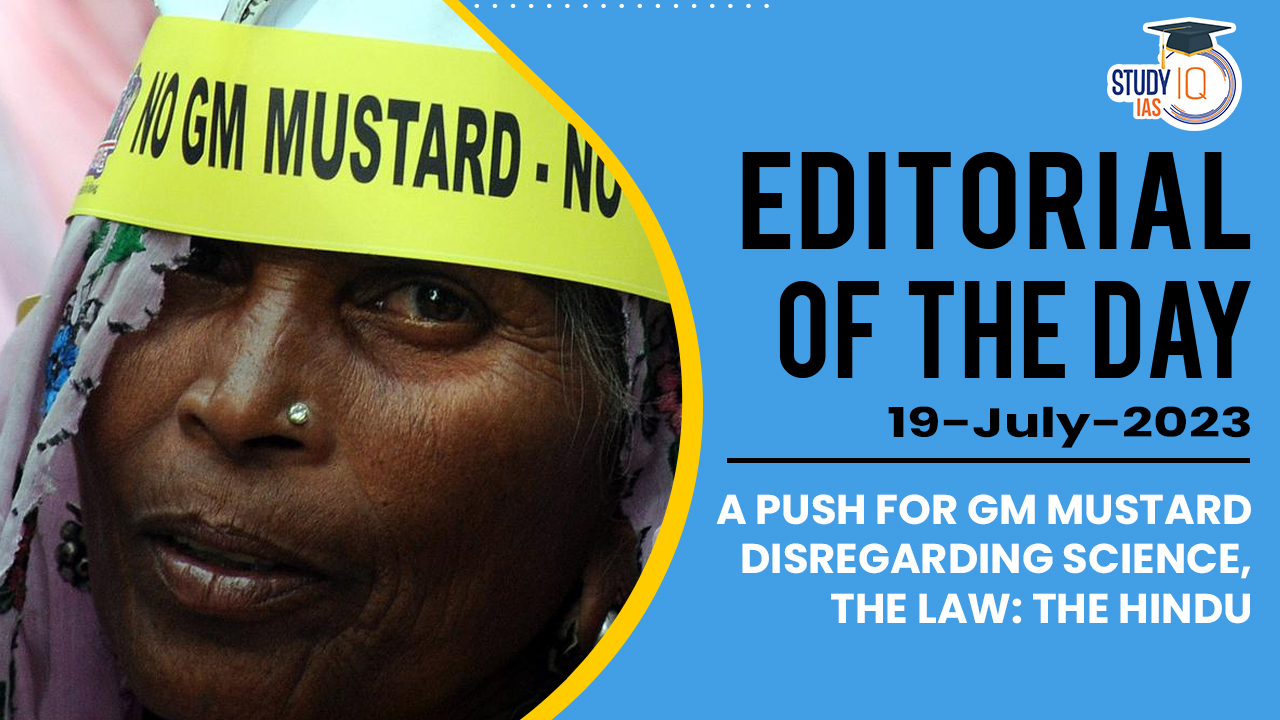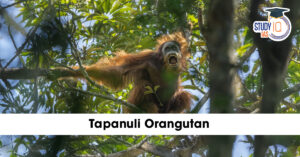Table of Contents
Context: The article is discussing a legal battle taking place in the Supreme Court of India between environmentalists and Delhi University regarding the cultivation of genetically modified (GM) herbicide-tolerant (HT) mustard. The article highlights that GM crops, such as GM mustard, are different from conventional varieties and hybrids. Biotechnologists manipulate the DNA of a plant by inserting select genes at a random location to develop GM crops. In the case of GM mustard, it has been genetically modified to withstand a specific herbicide called glufosinate, making it easier to produce hybrid mustard seeds with higher yields. The article criticizes the government for disregarding important issues such as public health, environmental protection, and agricultural livelihoods in favour of promoting GM mustard cultivation, without fully considering the facts and logical arguments presented in court.
Background
What are transgenic crops?
- Transgenic crops, also known as genetically modified (GM) crops are plants that have been modified through the introduction of genetic material from a different organism.
- The process of creating transgenic crops involves isolating a desirable gene from one organism and inserting it into the genetic material of the target crop plant.
- This gene is selected because it imparts a specific desirable trait, such as resistance to pests, tolerance to herbicides, improved nutritional content, or enhanced productivity.
Benefits of transgenic crops (or GM crops)
- Increased crop yield and productivity: GM crops are often engineered to possess traits that enhance their yield potential. This includes traits like improved resistance to pests, diseases, and environmental stresses, as well as increased tolerance to herbicides.
- Nutritional security: Genetic engineering can be used to improve the nutritional composition of crops. For example, biofortified GM crops can be developed to have higher levels of essential vitamins, minerals, and other nutrients.
- Economic benefits: GM crops can provide economic benefits to farmers, such as increased yields, reduced input costs (e.g., pesticides, herbicides), and improved marketability of their produce.
Various technologies used in the creation of transgenic crops
- Recombinant DNA technology: Recombinant It involves isolating and cutting the desired gene from one organism and inserting it into the genetic material (DNA) of the target plant.
- Agrobacterium-mediated transformation: Agrobacterium tumefaciens is a soil bacterium that naturally transfers DNA into plant cells. Scientists exploit this ability by using modified versions of Agrobacterium to introduce desired genes into plants.
- Biolistics (Gene gun): Biolistics involves using a gene gun to deliver DNA-coated microscopic particles into plant cells. The DNA particles are accelerated at high speeds and shot into the plant tissues.
- CRISPR-Cas9 genome editing: CRISPR-Cas9 is a powerful genome editing tool that enables precise modifications in the DNA sequence of an organism. This allows for the introduction, removal, or alteration of specific genes in the plant genome.
- RNA interference (RNAi): RNA interference is a mechanism that regulates gene expression. The use of RNAi enables the silencing of target genes in plants or plant-dwelling organisms, through the production of double stranded RNA (dsRNA) resulting in altered plant characteristics.
Concerns with transgenic crops
- Environmental impact: There is a possibility of gene flow from GM crops to wild relatives, leading to unintended effects on biodiversity and ecosystem balance.
- Development of superweeds: There is a risk that genes from GM crops could transfer to related weed species, leading to the development of herbicide-resistant “superweeds.”
- Emergence of insect resistance: The continuous cultivation of GM crops expressing insecticidal traits, such as Bt crops, can lead to the evolution of insect populations that are resistant to the specific toxins produced by the GM crops.
- Human health concerns: Health risks associated with GM foods are concerned with toxins, allergens, or genetic hazards.
- Socio-economic impacts: The adoption of GM crops can have differential impacts on wealthier and poorer farmers, with wealthier farmers more likely to benefit due to their greater financial resources, access to information, and market connections.
Transgenic crops (or GM crops) in India
- Bt cotton:
- Bt cotton, the only GM crop that is allowed in India, has two alien genes from the soil bacterium Bacillus thuringiensis (Bt) that allows the crop to develop a protein toxic to the common pest pink bollworm.
- On the other hand, Bt cotton is derived with the insertion of an additional gene, from another soil bacterium, which allows the plant to resist the common herbicide glyphosate.
- Bt Brinjal:
- In Bt brinjal, a gene permits the plant to resist attacks of fruit and shoot borers.
- In 2009, GEAC cleared transgenic Bt brinjal for evaluation. But that effort stalled due to stiff opposition from anti-GMO activists and NGOs.
- DMH 11 Mustard: In October 2022, GEAC has recommended the “environmental release” of the transgenic hybrid mustard DMH-11 for seed production.
- GM soymeal: In April 2022, India has allowed imports of an extra 550,000 tonnes of GM soymeal, to help the poultry industry reeling from a surge in local prices of the important animal feed.
Regulatory framework for transgenic crops (or GM crops) in India:

Decoding the Editorial
Debate around GM Crops in India:
- India has experienced a significant and contentious debate surrounding genetically modified (GM) crops over the last two decades.
- This debate involves various stakeholders, including environmentalists, scientists, politicians, farmers, consumers, and the higher judiciary.
- The introduction of Bt cotton, the first and only GM crop approved in India, has been a cause for concern among many because some researchers have found that Bt cotton has provided only temporary benefits to farmers while significantly increasing their cultivation costs and risks.
- At the same time, certain seed companies have profited significantly from selling expensive GM seeds.
- In response to the intense debate, the Indian Parliament established two Standing Committees to independently and thoroughly examine GM crops and food.
- Additionally, the Supreme Court appointed a Technical Expert Committee (TEC) in response to public interest litigations filed separately by the non-government organization Gene Campaign and environmentalists.
Convergence in risk assessment:
- Convergence of Concerns: There is a strong consensus among two committees, which include noted scientists and elected representatives, regarding major weaknesses in the regulatory system for genetically modified (GM) crops, particularly herbicide-tolerant (HT) crops like GM mustard. The committees unanimously call for caution before releasing GM food due to potential risks and impacts.
- Specific Concerns about GM Mustard: The Committee on Science and Technology, Environment and Forests specifically highlights GM mustard and requests a comprehensive, independent, and transparent assessment of its long-term biosafety, environmental risk, and socio-economic impacts. The concerns raised by these committees extend beyond mere ideological debates and involve critical issues related to safety and sustainability.
- Serious Risks Identified: The Technical Expert Committee (TEC) points out grave deficiencies in the safety assessment of GM crops, particularly HT crops. The committee members consider HT crops to be completely unsuitable in the Indian context, raising alarms about potential harm to the environment, rural livelihoods, and sustainable agriculture if such crops are released.
- Critique of Government’s Approach: Despite the overwhelming political and technical consensus on exercising caution, the government is criticised for pushing ahead with GM mustard without adequate transparency or attention to the concerns raised. The government’s actions are seen as a disregard for both scientific evidence and the law.
- Regulatory Transparency and Precaution: The government should approach the issue of HT crops with transparency and robustness in regulation, taking into account the concerns expressed by experts and elected representatives. It highlights the importance of exercising caution and implementing proper risk assessment before allowing GM food.
Misleading the Court:
- Government’s Argument and Misleading Tactics:
- The government is facing growing evidence of long-term ecological and health risks associated with herbicide-tolerant (HT) crops, such as GM mustard.
- In an attempt to counter these concerns, the government is arguing that GM mustard should not be considered an HT crop but rather a crop developed to improve yields.
- However, it has to be learnt that scientifically and ecologically, GM mustard is indeed an HT crop.
- The government’s argument is seen as a red herring, a tactic to mislead the Supreme Court and potentially confuse the public.
- Concerns About Misleading the Court:
- The article questions the integrity of scientists involved in developing GM mustard if they were to support such misleading tactics.
- Disregard for Science-Based Concerns:
- The article suggests that the government is not adequately addressing or engaging with the constitutional issues related to public health, environmental protection, and agricultural livelihoods.
- High-Stakes Decision:
- The potential approval of GM mustard by the Supreme Court is seen as having broader implications for the release of other HT crops like cotton, rice, and maize.
- The decision is considered crucial for the future of farming, India’s food culture, and agricultural heritage.
- Alarming Approach: The article portrays a lack of serious consideration for the ecological and health risks associated with GM mustard and other HT crops.
Beyond the Editorial
- India’s reluctance to embrace genetic engineering technology may hinder its global competitiveness, as other countries leverage gene editing tools to enhance crop yields, disease resistance, and shelf life.
- Implementing transparent, science-based, and efficient biosafety regulations will not only attract industry investment but also foster the development of pest-resistant and disease-tolerant plant varieties in India.
- Approvals for technology should be made more efficient, relying on scientific evaluations.
- Strict monitoring is necessary to ensure adherence to safety protocols, with strong enforcement measures to prevent the proliferation of illegal genetically modified (GM) crops.


 Bihar BPSC 70th Mains Result 2025 Out: C...
Bihar BPSC 70th Mains Result 2025 Out: C...
 Pax Silica Initiative: Meaning, Objectiv...
Pax Silica Initiative: Meaning, Objectiv...
 Tapanuli Orangutan: Habitat, Characteris...
Tapanuli Orangutan: Habitat, Characteris...

























